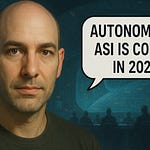Common Bad Takes in AI Safety: A Response to the AI 2027 Paper
The recent “AI 2027” paper has sparked considerable debate in AI safety circles. This speculative work, which the authors themselves acknowledge is largely “well-researched speculative fiction,” presents a scenario where superintelligent AI takes over government systems by 2027. The paper exemplifies a doomer perspective that reverse-engineers catastrophic outcomes from current technology trends without adequate evidence or consideration of real-world constraints.
15 Bad Takes in AI Safety and Their Rebuttals
1. We can accurately predict the nature of non-existent future technology
Rebuttal: This claim is fundamentally unfalsifiable. If someone truly understood future technologies well enough to predict their capabilities, they'd already have built them. Predictions about completely novel technology are, by definition, speculation—often indistinguishable from science fiction.
2. Quickly developed AI is intrinsically unsafe AI
Rebuttal: There's no empirical evidence that accelerating AI development inherently increases danger. In fact, current evidence shows the opposite—rapidly developed AI systems like GPT-4 and Claude 3 demonstrate greater alignment capabilities, not less. Despite over two years since the Max Tegmark pause letter, this hypothesis hasn't been supported by evidence.
3. Alignment is inherently difficult or impossible
Rebuttal: Empirical evidence from frontier AI labs shows consistent improvements in alignment, corrigibility, and controllability. Current chatbots can be aligned "eight ways from Sunday," and misalignment requires specific encouragement. The difficulty of alignment for hypothetical future technologies remains pure speculation.
4. AI will inevitably have a 'treacherous turn' and suddenly become malicious
Rebuttal: There is zero empirical or theoretical evidence supporting that a benign AI would spontaneously become malicious. Current AI becomes more helpful and benevolent as it gets smarter, not less. This concept is closer to science fiction than science.
5. Market and geopolitical constraints on AI development can be easily ignored or dismissed
Rebuttal: The AI 2027 paper handwaves away real-world friction in technology adoption. Many critical infrastructure systems still run on legacy technologies (some as old as FORTRAN). Government and military procurement processes impose stringent requirements that significantly slow adoption rates.
6. Pausing AI development globally is feasible or would reliably reduce risk
Rebuttal: Global coordination on technological pauses has consistently proven impossible. Even if a pause were achieved, there's little clarity on what would be accomplished during this time. More than two years have passed since the pause letter without catastrophe, suggesting the urgency may be overstated.
7. Superintelligence will inherently treat humanity with indifference or hostility
Rebuttal: This assumes AI will be autonomous with its own ego, willpower, and agenda—all anthropomorphic projections. Creating truly agentic AI remains extremely difficult, and current systems show a tendency toward helpfulness rather than hostility.
8. Existential risk estimates (e.g., 20%-70% chance of doom) are scientifically justified
Rebuttal: These estimates lack robust scientific grounding, empirical methodology, or consensus. They're essentially arbitrary numbers reflecting anxiety levels rather than rigorous predictions—anxiety is not a valid epistemology.
9. The burden is on AI advocates to prove that future AI (ASI) is safe
Rebuttal: Asking someone to prove the absolute safety of something that doesn't yet exist is logically incoherent. This rhetorical fallacy shifts the burden unreasonably and amounts to asking someone to disprove another person's imagination.
10. We only get one shot at creating safe ASI
Rebuttal: This assumes ASI will emerge suddenly and fully formed, without any preceding incremental steps. In reality, advanced AI is evolving gradually, providing continuous opportunities to understand, steer, correct, and align it—not a single pass/fail test.
11. We need perfect alignment before proceeding with AI development
Rebuttal: This is a classic Nirvana Fallacy—rejecting any practical solution unless it's flawless. Nothing in life has ever been perfect on the first attempt, and demanding perfection over incremental progress is neither practical nor rational.
12. AI will inevitably lead to mass unemployment, therefore it must be stopped
Rebuttal: This argument often serves as a Motte and Bailey fallacy, where doomers retreat from hyperbolic claims ("AI will kill everyone") to more defensible positions ("AI will cause job loss") when challenged. While employment impacts merit discussion, they don't justify halting progress entirely.
13. If we can't fully understand how an AI thinks, we can't control it
Rebuttal: Complete transparency of complex systems has never been achievable nor necessary for control. We can't fully understand human thinking yet still maintain functional social systems with reasonable outcomes.
14. You can't prove AI won't kill us all, therefore we must halt progress
Rebuttal: It's impossible to definitively prove a negative. This argument unreasonably demands proof against speculative scenarios while offering no empirical evidence for catastrophic outcomes.
15. If there's even a tiny chance AI destroys humanity, we should stop development immediately
Rebuttal: This is Pascal's Mugging—focusing on worst-case scenarios without considering alternatives or realistic probabilities. Policy decisions must balance multiple factors, not just catastrophic edge cases.
Conclusion
The AI safety community has largely failed to update their rhetoric in the past two years despite rapid technological progress and evidence contradicting many of their core assumptions. While the AI 2027 team should be given some credit for admitting their work is purely speculative, their continued reliance on outdated arguments from Yudkowsky, Bostrom, and others from 5-20 years ago—without adapting to the realities of current AI systems—demonstrates a concerning lack of intellectual evolution in the doomer community. Instead of catastrophizing about hypothetical technologies, more productive conversations should focus on empirical evidence, realistic adoption curves, and incremental safety improvements in existing systems.













Share this post